Welcome to the exciting world of Formula 1 racing! If you're a fan of this high-speed sport, you've probably noticed the flurry of activity that takes place in the pitlane during races. But have you ever stopped to think about all the different roles that make up a pitlane crew?
From mechanics to engineers, tire changers to fuelers, there are many specialized positions that work together to ensure a successful race for the team.
We take a closer look at the variety of roles within a pit crew and how each individual plays a crucial role in the success of a Formula 1 team. So buckle up and let's dive in!
Pitlane manager
As the leader of the pitlane crew, the manager plays a crucial role in coordinating the activities of the team and ensuring that everything runs smoothly during races. They are responsible for making strategic decisions about when to bring the car into the pits for repairs, tire changes, or refueling.
The managers also communicate with the team's engineers and drivers to gather information and make informed decisions.
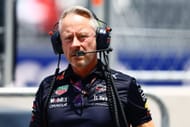
For example, during a race, the pitlane manager might receive a message from the driver that the car is experiencing a particular problem. The pitlane manager will then have to quickly assess the situation and decide whether to bring the car into the pits for repairs.
They might also consult with the engineers to discuss possible solutions and make a decision based on the data and information available.
In addition to making strategic decisions, the pitlane manager is also responsible for managing the team's budget and ensuring that all equipment and supplies are in good working order. They work closely with the team's sponsors and partners to ensure that the team has the resources it needs to succeed.
Formula 1 mechanics
When it comes to keeping the cars running smoothly during a race, mechanics play a crucial role in the pitlane crew. These skilled professionals are responsible for repairing and maintaining the vehicles, ensuring that they are in top condition for each race.
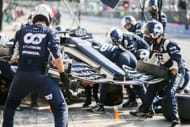
During the race, mechanics work closely with the engineers to diagnose and fix any problems that may arise with the car. This can range from simple tasks like changing a flat tire to more complex repairs like replacing a faulty engine component.
One example of the work that mechanics do in Formula 1 racing is preparing the cars for the next race. This involves thoroughly inspecting and servicing the vehicle, making any necessary repairs, and checking that all systems are working properly.
They also work with engineers to make necessary adjustments to the car's setup, such as changing the suspension or aerodynamics, to improve its performance on the track.
The lollipop man
This person is responsible for ensuring that a Formula 1 pit stop is completed safely and efficiently and that the car is ready to return to the track.
The lollipop man stands in front of the car with a large, vertical sign called a lollipop, which has a circular disc at the top and a long handle at the bottom.
When the pit stop is complete and the car is ready to go, the lollipop man or woman raises the disc above the handle, signaling to the driver that they can leave the pit box.
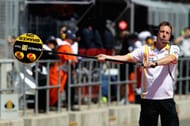
The lollipop man is also responsible for communicating with the driver and the rest of the pit crew during the pit stop. They may use hand signals or radio communication to give instructions or convey important information.
In recent times, this particular role has been replaced by an electronic system whose lights change, akin to the road traffic lights we're used to.
Engineers
Engineers are an integral part of any Formula 1 team, working closely with the mechanics and other members of the pitlane crew to design and implement strategies to improve the performance of the cars.
These highly talented professionals use their knowledge of engineering principles and technology to develop innovative solutions to the challenges faced by the team.
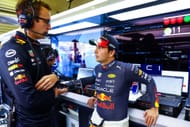
On race day, engineers work closely with the drivers and mechanics to gather data and analyze the performance of the cars. They use this information to identify areas where the team can make improvements and to develop strategies to optimize the car's performance.
Engineers might also work on designing and testing new components and technologies that could give the team an edge on the track.
In a Formula 1 team, there are several types of pit crew engineers who play important roles in the team's success on the track. These include:
Race engineers: These engineers work closely with the drivers and are responsible for setting up the car and making strategic decisions during the race. They analyze data from the car to understand its performance and make adjustments to improve it.
Data engineers: These Formula 1 engineers are responsible for gathering and analyzing data from the car to help the team make strategic decisions during the race. They may use specialized software and equipment to monitor the car's performance and identify areas for improvement.
Performance engineers: Formula 1 performance engineers focus on optimizing the car's performance through the use of advanced technologies and techniques. They may work on areas such as aerodynamics, suspension, and powertrain to improve the car's speed and handling.
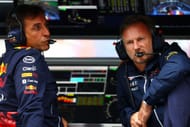
Reliability engineers: These engineers are responsible for ensuring that the car is reliable and able to finish races. They may work on improving the car's durability and identifying potential problems before they occur.
Mechanic engineers: These engineers work closely with the mechanics and are responsible for designing and developing the car's mechanical systems. They may work on areas such as the suspension, transmission, and brakes to improve the car's performance.
Overall, the pit crew engineers play a vital role in helping the team achieve success on the track by constantly working to improve the car's performance and reliability.
Tire changers
The Formula 1 Tire changers (who may be mechanics) play a crucial role in the pitlane crew, responsible for quickly changing the tires on the cars during pitstops. They work in coordination with the rest of the pitlane crew to ensure that the tires are changed as quickly and efficiently as possible.
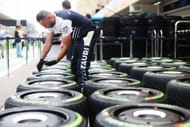
Tire changers are responsible for preparing the tires for the pitstop, which involves removing the old tires from the car and replacing them with fresh ones. They also need to make sure that the tires are properly inflated and heated and that the car is ready to get back on track as quickly as possible.
The responsibility of lifting and supporting the car during a pit stop is left to a group of men known as jackmen.
The main objective of jackmen is to lift the car off the ground during a pit stop, allowing the tire changers and mechanics to do their work efficiently and safely. The jackmen use hydraulic jacks to lift the car to a height that is comfortable for the tire changers and mechanics to work at.
These jacks are designed to lift the car quickly and smoothly, allowing the tire changers and mechanics to do their jobs efficiently and safely.
In addition to lifting the car, the jackmen are also responsible for ensuring that the car is stable and secure while work is being done. This is critical for the safety of the pit crew and the success of the pit stop.
In a Formula 1 pit crew, there are typically three types of jackmen: front, rear, and side.
Front jack men: These individuals are responsible for lifting and supporting the front of the car during a pit stop using a hydraulic jack. They work closely with the tire changers and mechanics to ensure that the front of the car is stable and secure while work is being done.
Rear jackmen: Formula 1 rear jackmen are responsible for lifting and supporting the rear of the car during a pit stop using a hydraulic jack.
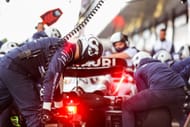
Side jackmen: Are responsible for lifting and supporting the sides of the car during a pit stop using a hydraulic jack. They may work on either the left or right side of the car, depending on the team's pit-stop strategy.
Before the pit stop begins, the front, rear, and side jack handlers will position themselves around the car and get ready to lift it off the ground. When the lollipop man gives the signal, they will use the hydraulic jacks to lift the car high enough for the tire changers and mechanics to do their work.
Once the pit stop is complete and the car is ready to go, the front, rear, and side jack handlers will lower the car back onto the ground using the hydraulic jacks. They must be careful to do this smoothly and steadily, as the driver will be returning to the track at high speeds and needs a stable platform to do so.
As you're certainly aware, Formula 1 pit crews are known for their lightning-fast pit stops, which often take less than three seconds to complete. This is made possible by the tireless training and practice of the pit crew members, as well as the use of advanced equipment and techniques.
One key factor in the speed of a Formula 1 pit stop is the coordination and teamwork of the pit crew. The tire changers and jackmen must work together seamlessly and efficiently, performing their tasks in a precise and coordinated manner.
The use of specialized equipment in Formula 1 also plays a role in the speed of a pit stop. Tire changers use pneumatic air guns to quickly loosen and tighten the tire bolts, while jackmen use hydraulic jacks to lift and lower the car smoothly and quickly.
In addition, the Formula 1 pit crew members themselves are highly trained and physically fit, with excellent hand-eye coordination and reflexes. They are able to perform their tasks quickly and accurately under pressure, thanks to the hours of practice and training they undergo.
Fuelers
These particular individuals work behind the scenes and are almost never seen, especially during the race, since mid-race refueling is illegal.
Formula 1 fuelers are responsible for preparing the fuel for the pitstop, which involves connecting the fuel hose to the car and ensuring that the right amount of fuel is added. They also need to make sure that the fuel is properly mixed and that the car is ready to get back on track as quickly as possible.
Data Analysts
In today's highly competitive world of Formula 1 racing, data plays a crucial role in helping teams identify opportunities for improvement and optimize the performance of their cars.
Data analysts are responsible for analyzing the vast amounts of data generated by the cars during races and practices, looking for patterns and trends that can help the team make informed decisions.

Formula 1 data analysts work closely with engineers and other members of the pitlane crew to gather and analyze data from the cars. They use specialized software and tools to process and visualize the data, looking for opportunities to improve the car's performance.
This might involve identifying issues with the car's setup or identifying areas where the team can make strategic changes to improve its performance on the track.
There are many different roles that make up a pitlane crew in Formula 1 racing. The size of a Formula 1 pit crew can vary depending on the team but a typical pit crew consists of around 20-25 people.
From pitlane managers to mechanics, engineers to tire changers, and fuelers to data analysts, each role plays a vital role in the success of the team.
It's easy to get caught up in the excitement of Formula 1 races and focus on the drivers but it's important to remember that there's a whole team working behind the scenes to make it all possible.
The next time you watch a Formula 1 race, take a moment to appreciate the diverse and highly skilled pitlane crew that makes it all happen.
Thanks for joining me on this special Formula 1 tour. I hope you've learned something new and gained a greater appreciation for the hard work and expertise that goes into making this exciting sport possible.
